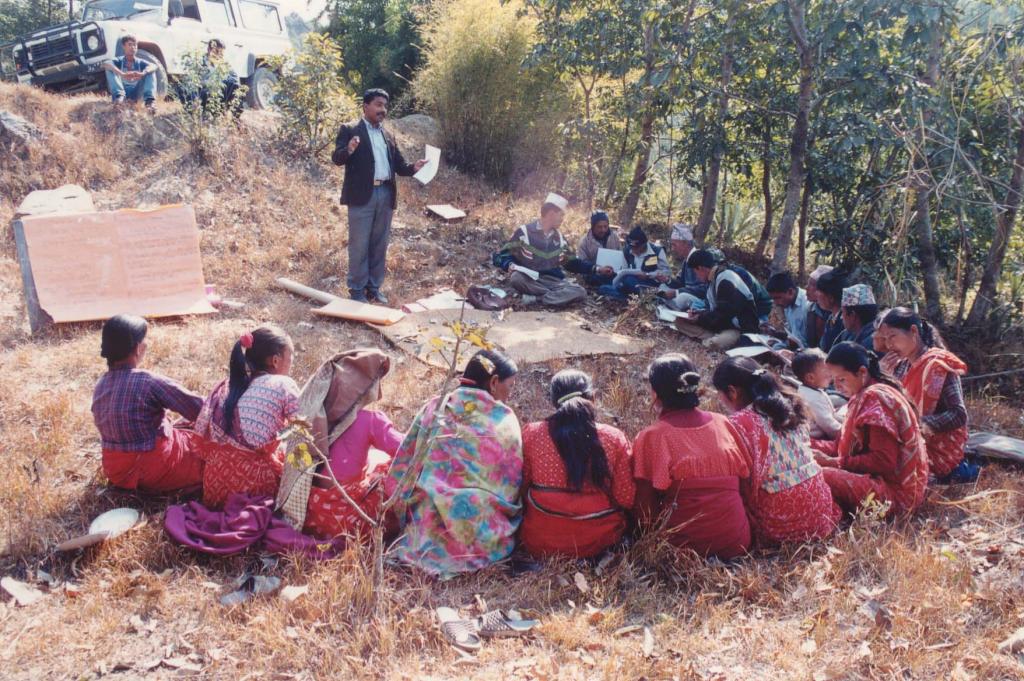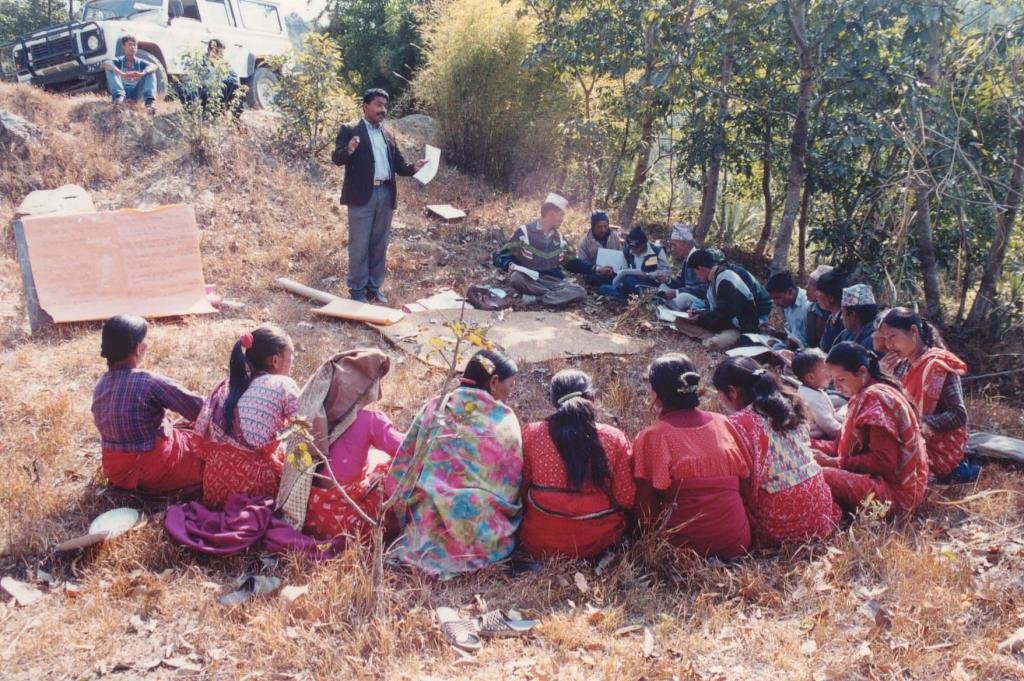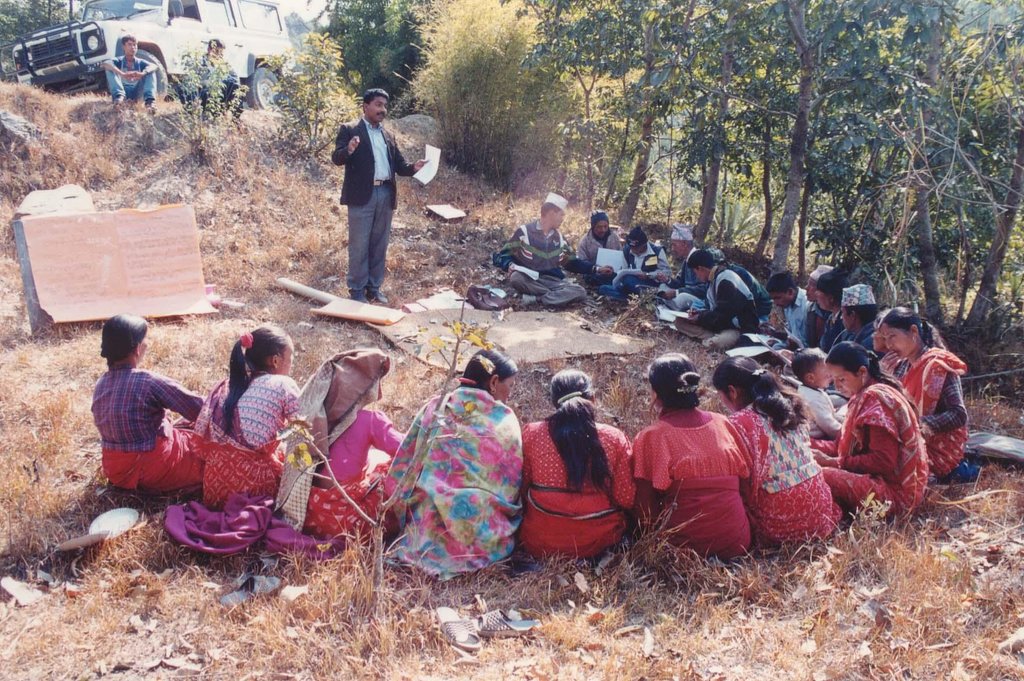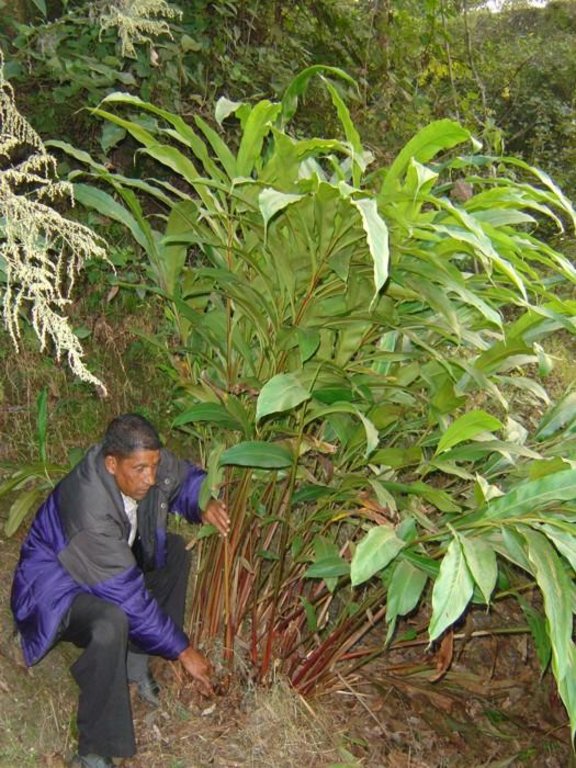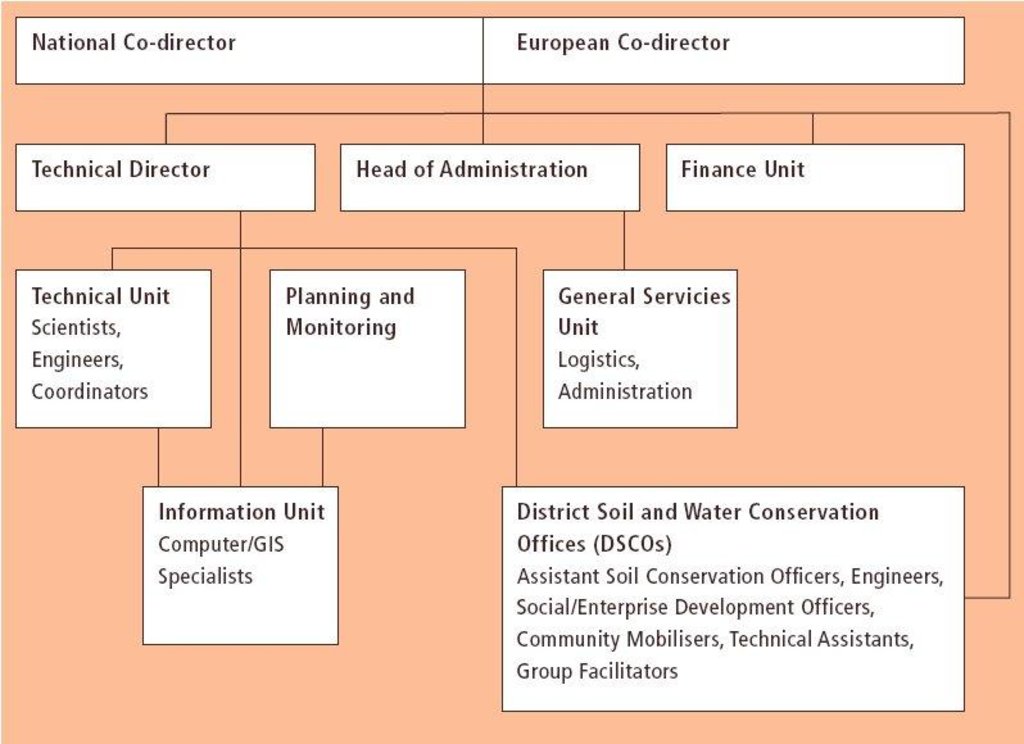Integrated watershed management for landslip and stream bank stabilisation [Nepal]
- Criação:
- Atualização:
- Compilador/a: Dileep Kumar Karna
- Editor: –
- Revisor: Fabian Ottiger
Pahiro ra nadikinar katan roktham ka lagi ekikrit jaladhar byabasthapan (Nepali)
approaches_2354 - Nepal
Veja as seções
Expandir tudo Recolher tudo1. Informação geral
1.2 Detalhes do contato das pessoas capacitadas e instituições envolvidas na avaliação e documentação da abordagem
Especialista em GST:
Especialista em GST:
Especialista em GST:
Nome da(s) instituição(ões) que facilitou(ram) a documentação/avaliação da Abordagem (se relevante)
G.B. Pant Institute of Himalayan Einvironment & Development (G.B. Pant Institute of Himalayan Einvironment & Development) - ÍndiaNome da(s) instituição(ões) que facilitou(ram) a documentação/avaliação da Abordagem (se relevante)
ICIMOD International Centre for Integrated Mountain Development (ICIMOD) - NepalNome da(s) instituição(ões) que facilitou(ram) a documentação/avaliação da Abordagem (se relevante)
CDE Centre for Development and Environment (CDE Centre for Development and Environment) - Suíça1.3 Condições em relação ao uso da informação documentada através de WOCAT
O/a compilador/a e a(s) pessoa(s) capacitada(s) aceitam as condições relativas ao uso de dados documentados através da WOCAT:
Sim
1.4 Referência ao(s) questionário(s) sobre tecnologias da GST
2. Descrição da abordagem de GST
2.1 Descrição curta da abordagem
Integrated watershed management as an example for landslip and stream bank stabilisation based on fostering a partnership between community institutions, line agencies, district authorities and consultants
2.2 Descrição detalhada da abordagem
Descrição detalhada da abordagem:
Aims / objectives: The sustainable management of mountain watersheds is a huge challenge for watershed management programmes due to the lack of collaboration between the various institutions involved. Building of synergies between these institutions is crucial for improved management. The Bagmati Integrated Watershed Management Programme (BIWMP) started in 1986, initiated, coordinated, and organised by the Department of Soil Conservation and Watershed Management with support from the European Commission. The programme aimed to help overcome natural resource degradation and thereby raise the standard of living of the rural population. The main causes of degradation and options to address the related problems were identified through participatory action research. Landslip and stream bank stabilisation was identified as one of the most promising and needed options to conserve soil and water, whilst providing direct livelihood benefits to local people, for example planting of large cardamom, later used as a cash crop, and reestablishment of damaged agricultural terrace above the landslip. The approach was to foster partnership between and among communities, district authorities, line agencies, and consultants. Key priorities were to ensure the equitable involvement of women and socially disadvantaged people and to promote local ownership, institutional capacity building, and sustainability.
Methods: The programme used participatory extension methods such as farmer-to-farmer exchange, training workshops, and onsite demonstrations, with participatory approaches to planning, implementing, and monitoring. The activities were based on villager’s priorities and were implemented by individual households, farmer groups, and village institutions. The local village development committee, local NGOs, community forest user group, and individual households worked together on landslip and stream bank stabilisation. Involving a range of stakeholders was paramount for success.
Stages of implementation: The first phase began in 1986 and focused on developing technical packages which were implemented through user groups. The second phase focused on improvements to implementation procedures, especially community organisation, extension, and income generation activities. The capacity of community groups was developed by establishing communication facilities, building up community networks, and empowering women and disadvantaged groups. BIWMP ended in 2003 with much of its success attributed to the close involvement of all the main stakeholders, and especially the local people, in all the activities. It successfully helped land users to adopt improved livelihood options.
2.3 Fotos da abordagem
2.5 País/região/locais onde a abordagem foi aplicada
País:
Nepal
Região/Estado/Província:
Bagmati Watershed
Map
×2.6 Datas de início e término da abordagem
Indique o ano de início:
1992
Ano de término (caso a abordagem não seja mais aplicada):
2003
2.7 Tipo de abordagem
- Baseado em projeto/programa
2.8 Principais metas/objetivos da abordagem
The Approach focused mainly on SLM with other activities (poverty reduction through sustained income generation, infrastructure improvement through equitable involvement of women and the socially disadvantaged.)
To overcome the constraints to effectively implementing a watershed management programme by building synergies between diverse stakeholder institutions. In the case of landslip and stream bank stabilisation work, the specific objective was to come up with a technology that conserved soil and water whilst also providing direct livelihood benefits to local people.
The SLM Approach addressed the following problems: Lack of institutional capacity and collaboration for managing watershed resources
2.9 Condição que propiciam ou inibem a implementação de tecnologia/tecnologias aplicada(s) segundo a abordagem
Normas e valores sociais/culturais/religiosos
- Inibitivo
Following conventional top-down approaches.
Treatment through the SLM Approach: Introduction of improved methods with more participation/ involvement of land users.
Quadro institucional
- Inibitivo
Lack of inter-institutional collaboration.
Treatment through the SLM Approach: Building and ensuring collaboration.
Quadro jurídico (posse de terra, direitos de uso da terra e da água)
- Propício
The existing land ownership, land use rights / water rights greatly helped the approach implementation: The fact that the land was communal land (state property, use right with community) greatly helped smooth implementation of the approach as it was not necessary to deal with different land users.
Conhecimento sobre GST, acesso a suporte técnico
- Inibitivo
Lack of new options.
Treatment through the SLM Approach: Training about new technologies.
3. Participação e papel das partes interessadas envolvidas
3.1 Partes interessadas envolvidas na abordagem e seus papéis
- Usuários de terra/comunidades locais
Men and women worked equally. existing groups of land users; men and women worked equally. BIWMP took a bottom-up approach to planning and implementation and encouraged the equitable involvement of women in its activities. The decisions about implementing the landslip and stream bank stabilisation technology were taken jointly by men and women
- Especialistas em GST/ consultor agrícola
- Professores/alunos/estudantes
- Governo nacional (planejadores, responsáveis pelas decisões)
- Organização internacional
Caso várias partes interessadas foram envolvidas, indique a agência líder:
For the landslip and stream bank stabilisation technology, the approach was mainly designed by programme staff of the Kathmandu District Soil Conservation Office.
3.2 Envolvimento do usuários de terra/comunidades locais nas diferentes fases da abordagem
| Envolvimento do usuários de terra/comunidades locais | Especifique quem estava envolvido e descreva as atividades | |
|---|---|---|
| Iniciação/motivação | Participativo | rapid/participatory rural appraisal |
| Planejamento | Participativo | rapid/participatory rural appraisal; Share information from users right from planning period. |
| Implementação | Participativo | responsible for major steps; Users were agreed to conserve soil by using SLM approaches. |
| Monitoramento/avaliação | Participativo | Mainly: reporting, public meetings, measurements/observations; partly: workshop/seminars; Regular monitoring and evaluation were successfully conducted by DSCO Office for the backstopping of the activities. |
| Research | Participativo | on-farm; This site is used as a Farmers School for extension of the technology on National and International level. |
3.3 Fluxograma (se disponível)
Descrição:
Organogram of the Bagmati Integrated Watershed Management Programme (BIWMP). The landslip and stream bank stabilisation work was implemented by the Kathmandu District Soil Conservation Office supervi
3.4 Decisão sobre a seleção de tecnologia/tecnologias de GST
Especifique quem decidiu sobre a seleção de tecnologia/tecnologias a serem implementadas:
- Principalmente especialistas em GST, após consulta com usuários da terra
Explique:
The land users did not know about the technologies
Decisions on the method of implementing the SLM Technology were made by mainly by SLM specialists with consultation of land users. As measures required technical know-how
4. Suporte técnico, reforço das capacidades e gestão do conhecimento
4.1 Reforço das capacidades/ formação
Foi oferecida formação aos usuários da terra/outras partes interessadas?
Sim
Especifique quem foi capacitado:
- Usuários de terra
Tipo de formação:
- Agricultor para agricultor
- Áreas de demonstração
- Reuniões públicas
Assuntos abordados:
On soil and water conservation
4.2 Serviço de consultoria
Os usuários de terra têm acesso a um serviço de consultoria?
Sim
Especifique se foi oferecido serviço de consultoria:
- nas áreas dos usuários da terra
Descreva/comentários:
Name of method used for advisory service: Integrated Watershed Management Programme; Key elements: Participatory Rural Appraisal, Trainings, Farmer to farmer exchange, workshops, seminars, On site Demnostration; 1) Advisory service was carried out through: government's existing extension system; Extension staff: mainly government employees 2) Target groups for extension: land users; Activities: Planning,Training, Awareness about SLM approaches
Advisory service is quite adequate to ensure the continuation of land conservation activities; An extension workers is able to cover the areas where activities are implemented in small scale (i.e. subwatreshed or Micro subwatershed level programme).
4.3 Fortalecimento da instituição (desenvolvimento organizacional)
As instituições foram fortalecidas ou estabelecidas através da abordagem?
- Sim, significativamente
Especifique a que nível (níveis) as instituições foram fortalecidas ou estabelecidas:
- Local
Especifique o tipo de apoio:
- Reforço das capacidades/ formação
- Equipamento
4.4 Monitoramento e avaliação
Monitoramento e avaliação são partes da abordagem?
Sim
Comentários:
bio-physical aspects were ad hoc monitored through measurements
technical aspects were regular monitored through observations
socio-cultural aspects were regular monitored through observations
economic / production aspects were regular monitored through observations
area treated aspects were ad hoc monitored through measurements
no. of land users involved aspects were regular monitored through observations
management of Approach aspects were regular monitored through observations
There were many changes in the Approach as a result of monitoring and evaluation: The approach described was designed on the basis of the results shown through monitoring and evaluating the first phase of BIWMP (1986-1992). In the second phase from 1992, more attention was focused on building up the capacity of community groups to plan, implement, and continue development activities. Capacity was built through (1) community-level training; (2) supporting the installation of com
4.5 Pesquisa
A pesquisa foi parte da abordagem?
Sim
Especifique os tópicos:
- Sociologia
- Economia/Marketing
- Ecologia
- Tecnologia
Dê mais detalhes e indique quem realizou a pesquisa:
see also further reading
5. Financiamento e apoio material externo
5.1 Orçamento anual para o componente de GST da abordagem
Caso o orçamento exato seja desconhecido, indique a faixa:
- > 1.000.000
Comentários (p. ex. principais fontes de recursos/principais doadores):
Approach costs were met by the following donors: international (European Commission): 81.0%; government (national - His Majesty's Government (Nepal)): 4.0%; local community / land user(s) (Bagmati watershed): 15.0%
5.2 Apoio financeiro/material concedido aos usuários da terra
Os usuários da terra receberam apoio financeiro/material para a implementação de tecnologia/tecnologias?
Sim
5.3 Subsídios para entradas específicas (incluindo mão-de-obra)
- Agrícola
| Especifique quais entradas foram subsidiadas | Em que medida | Especifique os subsídios |
|---|---|---|
| Sementes | ||
| Seedlings and samples | Parcialmente financiado | |
- Construção
| Especifique quais entradas foram subsidiadas | Em que medida | Especifique os subsídios |
|---|---|---|
| community infrastructure (cement, bricks, stones) | Totalmente financiado | |
Se a mão-de-obra pelos usuários da terra foi uma entrada substancial, isso foi:
- Voluntário
Comentários:
About 75% of the labour for the landslip and stream bank stabilisation work was voluntar. The remainder was paid
5.4 Crédito
Foi concedido crédito segundo a abordagem para atividades de GST?
Não
6. Análise de impactos e declarações finais
6.1 Impactos da abordagem
A abordagem auxiliou os usuários da terra a implementar e manter as tecnologias de GST?
- Não
- Sim, pouco
- Sim, moderadamente
- Sim, significativamente
The approach helped to improve soil and water management by promoting many activities related to agroforestry, water harvesting, landslip stabilisation, and community forestry. Many local land users adopted these technologies.
A abordagem melhorou as questões de posse de terra/diretos do usuário que inibiam a implementação das tecnologias de GST?
- Não
- Sim, pouco
- Sim, moderadamente
- Sim, significativamente
By influencing the forest department ot allocate forest to the people as community forest.
Did other land users / projects adopt the Approach?
- Não
- Sim, pouco
- Sim, moderadamente
- Sim, significativamente
It is not known whether this approach has been taken to address landslip and stream bank erosion problems in other areas by other projects.
6.3 Atividades de sustentabilidade de abordagem
Os usuários da terra podem manter o que foi implementado através da abordagem (sem apoio externo)?
- Incerto
Caso negativo ou incerto, especifique e comente:
The land users were keen on maintaining the implemented technologies due to the benefits they could get from it. There has to be a strong driving force within the land users and the community to continue this approach.
6.4 Pontos fortes/vantagens da abordagem
| Pontos fortes/vantagens/oportunidades na visão do usuário da terra |
|---|
| Helped land users improve their livelihoods. (How to sustain/ enhance this strength: Similar approaches should be implemented by government and community programmes.) |
| Pontos fortes/vantagens/oportunidades na visão do/a compilador/a ou de outra pessoa capacitada |
|---|
| Involves all key actors in watershed management. (How to sustain/ enhance this strength: Institutionalise the approach.) |
| The approach encourages land users communities and local institutions to get involved in planning and decision making (How to sustain/ enhance this strength: Involve them more in planning and decision making) |
| The implementation of technologies through this approach is cost-effective and socio-culturally acceptable. (How to sustain/ enhance this strength: Take into account local resources and knowledge) |
6.5 Pontos fracos, desvantagens da tecnologia e formas de superá-los
| Pontos fracos/desvantagens/riscos na visão do usuário da terra | Como eles podem ser superados? |
|---|---|
| No opinion. |
| Pontos fracos/vantagens/riscos na visão do/a compilador/a ou de outra pessoa capacitada | Como eles podem ser superados? |
|---|---|
| Some activities with high input requirements may not be spontaneously adopted by poor land users | Further research on how to reduce inputs or provide specifi c incentives for such disadvantaged groups. |
| The approach is 'project focussed' | Institutionalise the approach |
| The approach does not focus on landless families. | Implement watershed management activities that involve and benefit landless people |
7. Referências e links
7.1 Métodos/fontes de informação
- visitas de campo, pesquisas de campo
- entrevistas com usuários de terras
7.2 Referências às publicações disponíveis
Título, autor, ano, ISBN:
Mallik, D.B. (2000) 'Working with Community'. In Jaladhar-QuarterlyBIWM (1998 to 2001) Annual Workplans for Project Years 1998 to 2002, prepared for Government of Nepal,MOFS,DSCWM and EU; Kathmandu, Nepal
Disponível de onde? Custos?
BIWMPBIWMP email: biwmp@mos.com.np
Título, autor, ano, ISBN:
BIWM (1998 to 2001) Annual Workplans for Project Years 1998 to 2002, prepared for Government of Nepal,MOFS,DSCWM and EU; Kathmandu, Nepal
Disponível de onde? Custos?
BIWMP email: biwmp@mos.com.np
Links e módulos
Expandir tudo Recolher tudoLinks
Não há links
Módulos
Não há módulos


